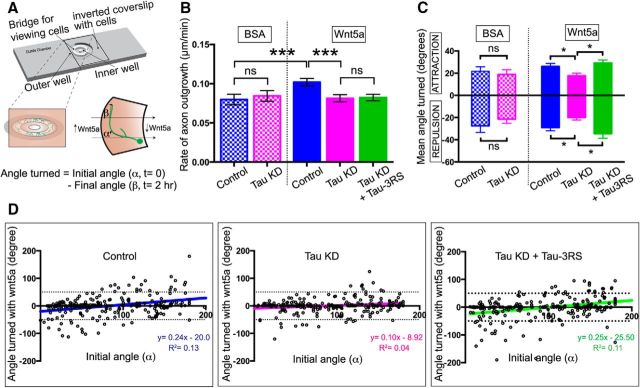Figure 9.
Tau knockdown reduces axon outgrowth and growth cone turning in Wnt5a gradients. Schematic of a Dunn chamber (A) showing a cortical neuron growing in the Wnt5a gradient in the bridge region of the chamber. High to low Wnt5a gradient is indicated by the shading. The initial and final direction of axon outgrowth was defined by the direction of the 5 μm distal axon segment. The initial angle (α) is defined by the original direction of axon outgrowth and a line through the Wnt5a gradient. The final angle (β) was calculated as the angle between the final direction of axon outgrowth and a line through the Wnt5a gradient. Histograms (B) show rates of axon outgrowth of neurons in Dunn chamber Wnt5a gradients over 2 h. Wnt5a increases the rate of axon outgrowth by 20% but following tau knockdown Wnt5a fails to accelerate axon outgrowth. Rescue with a single 3RS human tau construct fails to rescue the rate of axon outgrowth. Histograms of mean turning angles (C) of control versus tau knockdown axons (N = 100 axons for each condition) in BSA and Wnt5a gradients during live-cell imaging for 2 h at 10 min intervals. Growth cones in BSA show equal amounts of attractive and repulsive turning, which is not significantly changed by tau knockdown. In Wnt5a gradients growth cones show slightly more repulsion than attraction to the gradient and tau knockdown significantly reduces turning angles in either direction. Rescue with a single 3RS human tau isoform is sufficient to restore turning angles to control levels. Scatter plots (D) of mean turning angles of individual growth cones measured in the histograms. The x-axis represents the initial angle of the growth cone (α) in relation to the Wnt5a gradient. Mean turning angles (the initial angle minus the final angle) are indicated by dots for each growth cone. Colored lines represent the best-fit linear regression of mean turning angles. *p < 0.05, ***p < 0.001.

